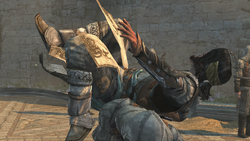- "The hookblade helps you get around fast, surprise guards, and is not too bad in a fight."
- ―Yusuf Tazim.[src]

Concept art of the hookblade.
The Hookblade was a modification to the Hidden Blade first adopted by the Assassins Guild of Constantinople. It consisted of both a curved hook, as well as a regular blade, allowing it to be used for freerunning and in combat.
When he arrived in the city, the Mentor Ezio Auditore was introduced to this advancement by Yusuf Tazim, who instructed the former in its use in both battle and travel.
Usage
- "Let the hookblade do the work. Iste boyle! (There you go!) Throw yourself into it."
- ―Yusuf describing the method of using the hookblade.[src]
Ezio using the hookblade on a zipline.
Used from as early as the 1480s, the hookblade was designed to make travel quick and easy, specifically by allowing the use of ziplines existing throughout the city. From a zipline, an Assassin could drop down and use the hookblade in double assassinations onto guards below.
It could be used in several acrobatic movements, such as for quickly climbing up walls in a similar manner to the climb-leap manouvre, and for extending one's reach during a jump.
It could also be used for flipping over enemies to avoid a fight, a method the Assassins referred to as the "hook and run."
The hook and run could be used on any enemy, and could be used to escape while in mid-combat. However, using the technique on a Janissary led to the hookblade getting caught on their armor, slowing the Assassin down slightly.

Yusuf performing a hook and run.
When climbing, the hookblade allowed an Assassin to spring quickly onto a rooftop after grabbing the ledge, rather than spending extra time gaining a foothold and pulling themselves up. Similarly, one did not need a foothold when pulling a target guard off a roof in ledge assassinations.
Additionally, it could be used with corner chase-breakers, where the swinging support could be used as a trapeze to jump to the next rooftop, instead of going around the corner.
Combat
When engaging in battle, an Assassin could use the hookblade to pull targets in for a close-range attack, or throw an enemy onto the ground with the "hook and throw," a method similar to the hook and run.
Ezio countering an enemy with the hookblade.
In combat itself, the hookblade could be used in attacks, or to counter a weapon. One could hook onto an enemy's armor and bodily throw them onto the ground, or hook onto an enemy's helmet to snap their neck.
An Assassin could also perform a counter steal to tear off an enemy's purse with the hookblade, provoking them further and leaving them open to an easy counter attack.
The hookblade could also be used to pull down scaffolds, subsequently slowing down or eliminating pursuers. This was particularly useful when done in conjunction with caltrop bombs.
Trivia
- Early images of Assassin's Creed: Revelations show Ezio with a hookblade on his left arm, rather than his right. In these, the hook is incorporated directly onto the blade, rather than separate.
- Developer Ubisoft Montreal has stated that the hookblade should increase navigation speed by 30%.
- The actual hook of the hookblade resembles the head of an eagle, a bird frequently associated with the Assassin Order.
- Unlike the Hidden Gun and Poison Blade, the hookblade is an upgrade for Ezio's secondary hidden blade, rather than his primary one.
- The hookblade is also used by the Revelations multiplayer characters.
- Bomb-crafting stations are unlocked using the hookblade.
Gallery
Video
thumb|left|Assassin's Creed: Revelations Hookblade Trailer.
Source
| |||||||||||||||||||||||||||||||||||||




